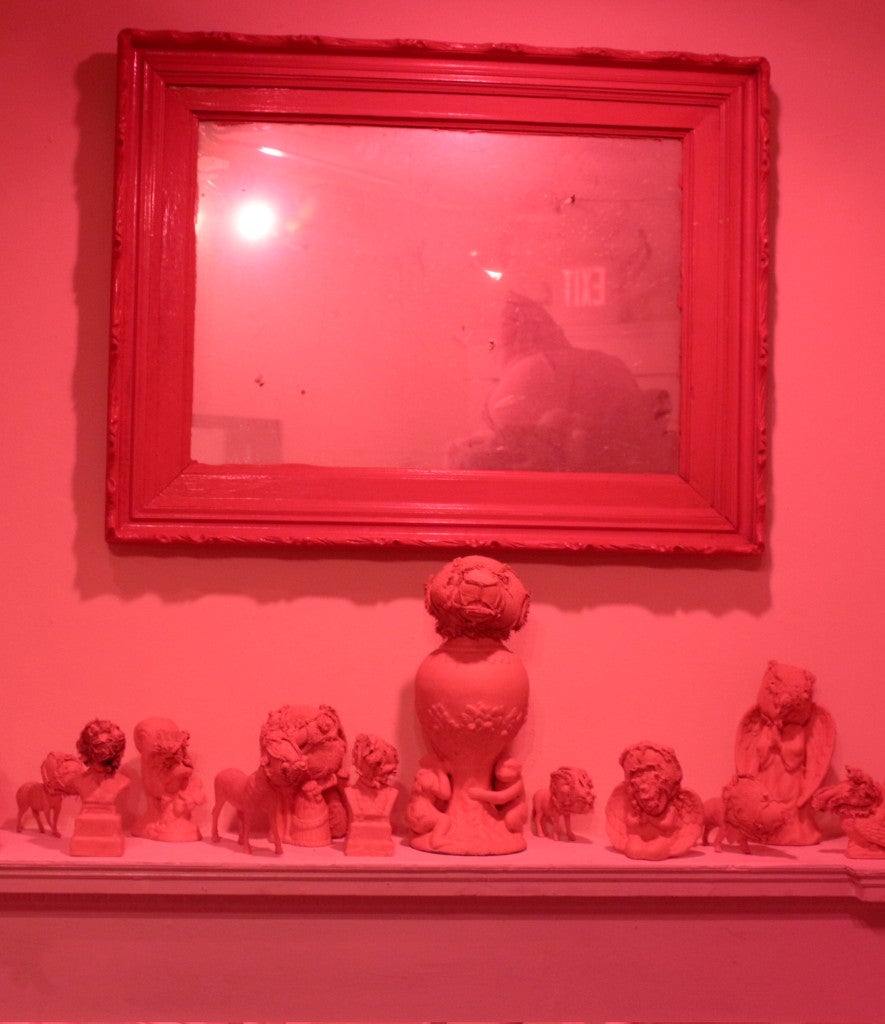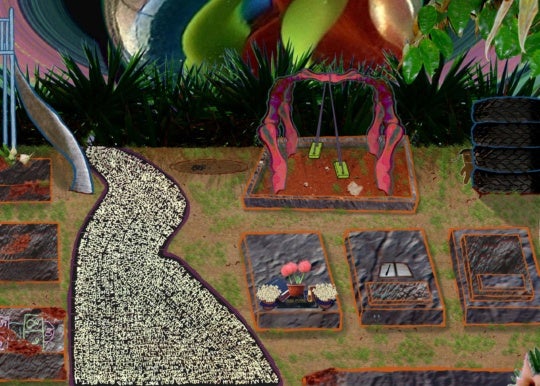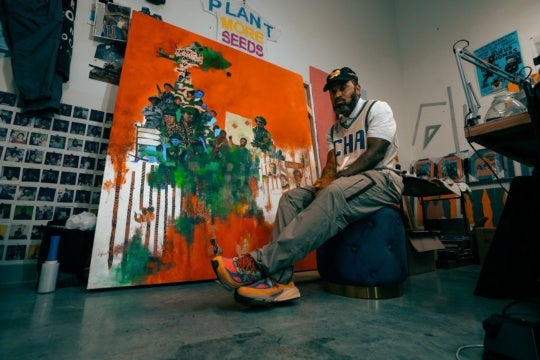
Mike Stasny and George Long’s show I FUCKING L*** YOU, on view at Kibbee Gallery through February 22, is, in a sense, a monument to their loved ones in Atlanta—an appropriate theme for the month of February, the supposed month of love, hearts, and Cupid’s arrows. The show consists of 81 sculptural pieces, each named after a friend, including artists, curators, and arts administrators Henry Detweiler, Nikita Gale, Jill Frank, Susan Bridges, Susannah Darrow (executive director of BURNAWAY), and, in full disclosure, me. These pieces, made of torn and de-stuffed stuffed animals, thrift-store statues and other tchotchkes, and wood, among other materials, are arranged throughout the gallery as mantle pieces, wall sconces, and stand-alone totems.
Even though the gallery is bathed in pink light and many of the materials used are soft and furry, these arrangements create a strange and sinister affect in the viewer; the installation simultaneously evokes feelings of a statuary garden, an antique or junk shop, a deranged grandmother’s house, and a headstone emporium. In an email conversation, Stasny and Long described the sculptures as “ironic effigies of love” and “visual jokes.” There is something deeply humorous about the show, but at the same time, something sort of terrifying. The centerpiece of the show, for example, is a love-monster, what I like to call the formidable dance partner. I’d really like to take his claw-like hand in mine, but I’m afraid he might scratch me.

I FUCKING L*** YOU embodies the ways in which love evokes trajectories of both life and death. We have only to call to mind the tragic love of Romeo and Juliet. What is it about love that elicits these radically opposed states? In one sense, the show stages the playful drinking party described in Plato’s Symposium. In another, a Freudian sense, these sculptures exhibit a bubbling-up of the unconscious and its paradoxical desires to create and destroy.
Plato’s Symposium recounts a series of speeches to Eros, the god of love. One of the mock encomiums speaks particularly well to the effigies Stasny and Long have made of their beloved friends. Aristophanes’ narrative describes how we used to be two bodies in one—with four arms, four legs, two faces—but were cut in half by the gods, who saw us as too powerful and threatening, He posits that we are all looking for our missing half. We can’t seem to get over the violent partition. The sculptures populating Kibbee suggest that they are stitched-together reconnections of parts that were initially torn apart by this destructive force.
For Freud, Eros is what drives life to maintain itself on its way towards death, a morbid sort of love. Freud describes Eros as a drive connected to both pleasure and death; it aims toward homeostasis while also tending toward the ego’s destruction. According to Freud, these two drives —Eros and death—are inextricably intertwined: “The emergence of life would thus be the cause of the continuance of life and also at the same time of the striving towards death; and life itself would be a conflict and compromise between these two trends.”
If we follow these contradictory tendencies literally, I FUCKING L*** YOU exemplifies the drive to create out of the love that is also destructive. This love prompted the ripping apart of seemingly innocent teddy bears, transmuting them into new bodies.

Stasny and Long’s sculptures carry with them this sense of an oscillating Eros. They stand in the gallery as intermediaries between the beautiful and the terrifying; the aesthetic pleasure they produce is at the same time unsettling. The pink that permeates the gallery space is sweet to the point of almost nauseatingly saccharine, threatening to swallow you whole—a constant vacillation between delightful and dreadful. Socrates states in his speech in Symposium that Eros desires the good and the beautiful, which means he cannot already be the good and the beautiful; to desire something means that you don’t already have it. However, for Eros to recognize these virtues as desirable, he must contain a certain amount of them within himself; he must not be entirely ignorant and ugly. If Eros was constituted only by the vulgar, he would not seek the best—Eros needs to lie in the space between the two extremes.
Philosopher Sarah Kofman states that “Love is a daemon.” To this I wonder whether the formidable dance partner is a demon or angel, enemy or lover? Both or neither?
Don’t miss the Wear Pink Party at Kibbee on February 14, the official Hallmark day of love, featuring a performance by Lavonia Elberton and noshes by the Good Food Truck.
Meredith Kooi is the editor of Radius, an experimental radio broadcast platform based in Chicago. She is currently a PhD student in the Graduate Institute of the Liberal Arts at Emory University, a performance and visual artist, and a monthly contributor to Bad At Sports.




